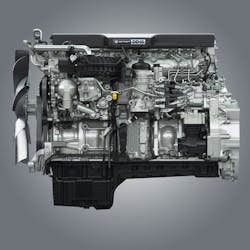Finding the efficiency sweet spot in trucking
Extended roof fairings and air deflectors, cab extenders to close the tractor-trailer gap, cab-to-skirt closeouts, tire pressure monitoring, trailer skirts—and the list goes on. These features can help on-highway trucks reduce aerodynamic drag and improve fuel economy, a major part of the total cost of ownership (TCO) equation for commercial carriers today.
Because TCO is truly the end goal for over-the-road trucking operations, both truck and trailer manufacturers continue to work out ways to help fleets reduce drag and parasitic losses on their equipment.
Uptime also is a major part of that efficiency equation. And as COVID-19-related supply chain constraints have shown us all, equipment trends that enhance capacity and productivity will never go out of style.
“Our customers’ North Star is always lowest total cost of ownership,” explained Mary Aufdemberg, general manager of product strategy and market development for Daimler Truck North America (DTNA). “This requires, among other things, maximum efficiency and uptime for owners and operators.”
For Chet Ciesielski, VP of Navistar’s on-highway truck business, TCO for his segment starts with fuel efficiency. To enhance fleet fuel economy efforts, Navistar has put a great deal of emphasis on adding aerodynamic devices and features to its International LT and RH Series on-highway tractors.“We really want to focus and work with the fleets,” Ciesielski said. “The fleets still have to have control of what they’re using and what their speed configurations are.”
In addition to fuel efficiency and uptime, major trucking OEMs also are seeing growing trends toward sustainability. Aside from companies investing in and adopting environmental, social, and corporate governance plans, federal greenhouse gas (GHG) emissions regulations for 2024 and 2027 are precipitating significant changes for diesel powertrain offerings.
Emissions reduction, fuel efficiency
When considering future equipment trends and offerings, manufacturers are prioritizing what fleets are asking for while ensuring equipment complies with both current and incoming regulations.
“Everybody wants fuel economy, and everybody wants performance,” Navistar’s Ciesielski explained. “The regulatory compliance roadmap shows you that in the next six years, there are a lot of reductions coming in place that will drive electrification. Government is driving toward improved fuel, which helps the fleet, and it’s also driving us toward a more electrified future.”
Without question, however, even as the industry moves toward that electric future, the internal combustion engine will continue to play a leading role. And diesel will be around for many years to come.
“We have to make continuous improvements on those products because the fleets will be running those on a large scale for at least the next five to 10 years,” Ciesielski advised.
Navistar’s enhanced International A26 engine, for example, shows a fuel economy improvement of 4% to 5%. For the future, Navistar’s next-generation engine, expected for the 2023-2024 timeframe, Ciesielski said, will highlight even greater output improvements.DTNA has seen both a “push and pull demand,” where fleets are asking for newer technologies to achieve their own sustainability goals as it seeks to offer products with a continually diminishing carbon footprint, Aufdemberg pointed out. DTNA has plans to offer exclusively CO2-neutral vehicles (tank to wheel) in the U.S. market by 2039.
As part of that effort, DTNA continues to invest in its Detroit integrated powertrain and aerodynamics for the Freightliner Cascadia. Since its model introduction in 2007, the Cascadia’s fuel efficiency has improved nearly 35%, Aufdemberg explained. And when the Detroit DD15 Gen5 engine was introduced in 2020, it achieved more than 3% fuel economy improvement and allowed DTNA to exceed the federal GHG Phase II standards, she added.
“While I cannot speak to future product enhancements just yet, 2024 and 2027 emissions regulations are sure to precipitate big changes on diesel offerings, and DTNA is committed to improving diesel technology to benefit our customers and meet regulatory requirements,” Aufdemberg emphasized.Volvo Trucks North America (VTNA) is also working to drive the industry’s shift toward sustainability and zero emissions in transport.
Johan Agebrand, product marketing director at VTNA, said the company’s overarching target is to help minimize fleet customers’ environmental footprint as well as its own. Part of that strategy included Volvo’s decision in 2021 to make the Next Generation D13 Turbo Compound standard on all VNL sleeper models.
In the Volvo VNL 740, 760, and 860 models, the D13TC engine works to offer more fuel savings for a wider range of applications, such as long haul or local delivery, as well as fully or partially loaded. According to Volvo, the D13TC engine delivers improved fuel efficiency of up to 11% compared to 2015 Volvo truck models.
While Paccar’s Peterbilt is working to enhance fuel-efficiency improvements for fleet customers, the company is also focused on designs to make drivers more productive.
Some of those designs include enhanced visibility around the vehicle and the ease of getting in and out of the truck, Scott Newhouse, chief engineer for Peterbilt, told FleetOwner during CES 2022 in Las Vegas in early January. “That is making an operator less tired and more productive behind the wheel,” Newhouse said. “We think productivity is efficiency, and some of those are key things in making fleets more efficient.”
Paccar recently launched torque-overlay steering for Peterbilt and Kenworth trucks, Newhouse noted as another example of equipment efficiency trends. “It’s steering assistance that helps in backing maneuvering at slow speeds, which reduces additional stress on drivers,” he said.
Trailer efficiency and uptime
Like tractors, trailers also play a pivotal role when it comes to overall efficiency and fuel economy benefits in commercial trucking operations. And fleets, along with manufacturers, are focusing on smart trailer attributes to maximize uptime, which has become increasingly important during ongoing equipment shortages and build delays, explained Bill Hicks, product manager for SAF-Holland.
“By monitoring and communicating any operational issue before a trailer goes into service, the fleet manager can address any situation beforehand,” Hicks pointed out. “This allows for controlling service costs and scheduling as well as replacement part ordering in a timely and cost-effective manner.”
For customers of Stoughton Trailers, efficiency revolves around keeping trucks moving and hauling freight, explained Dave Giesen, VP of sales.
“What this means to them is having the necessary ready and empty trailers when they need them so drivers do not have to wait,” Giesen said. “They just need more trailers to do this.”
Giesen also noted that tracking and loaded/unloaded technology has a real impact on gaining efficiency. Several other new technologies will help with predicting trailer maintenance needs and monitoring the overall health of the asset.
The future of trailer efficiency likely will have skirts even more prevalent than today as they offer the biggest real fuel savings, Giesen pointed out. According to the North American Council for Freight Efficiency, trailer skirts are the most popular devices for addressing drag, offering 1% to more than 5% fuel savings versus trailers that don't have them onboard.
Late last year, however, trailers were removed from the latest GHG Phase II regulations after a panel of judges determined that because trailers have no motor and don’t use fuel, they don’t have to be governed under federal fuel requirements. However, fleets are continuing to adopt changes that will have an immediate ROI impact for their operations.
“Fleets will look at the cost of improvements and weigh against the actual gains they will see in reduced fuel consumption,” Giesen added. “This leads to good business decisions.”
Over time, federal regulatory agencies will mandate certain key attributes, such as temperature monitoring on refrigerated cargo, are monitored to ensure safety, product quality, and fuel efficiency, SAF-Holland’s Hicks noted.
Ultimately, when referring to smart trailers, Hicks said that the key functioning parameters of SAF-Holland’s products need to be “sensorized” and integrated into designs to provide the end user with actionable data.
This article originally appeared on FleetOwner.com.
About the Author

Cristina Commendatore
Cristina Commendatore is the Executive Editor of FleetOwner magazine. She has reported on the transportation industry since 2015, covering topics such as business operational challenges, driver and technician shortages, truck safety, and new vehicle technologies. She holds a master’s degree in journalism from Quinnipiac University in Hamden, Connecticut.



